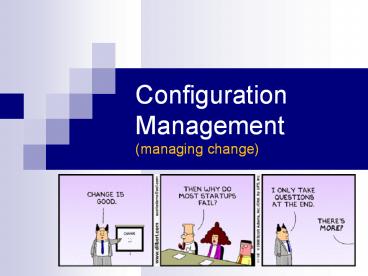Configuration Management (managing change) - PowerPoint PPT Presentation
Title:
Configuration Management (managing change)
Description:
Configuration Management (managing change) Starter Questions... Which is more important? stability progress Why is change potentially dangerous? – PowerPoint PPT presentation
Number of Views:438
Avg rating:3.0/5.0
Title: Configuration Management (managing change)
1
Configuration Management(managing change)
2
Starter Questions...
- Which is more important?
- reliability and stability
- unrestrained progress
- Why is change potentially dangerous?
- What causes configuration problems?
- multiple developers
- multiple releases
- components used in multiple products
- changing requirements
- etc...
3
Change is inevitable.
AND
Change creates confusion.
BUT,
Confusion is NOT inevitable.
4
Outline for Tonight
- "Baselines"
- CM Repository and Config Tools
- CM Plan
Much of this Software Configuration Management
presentation is based on Chapter 27 of
Pressman's Software Engineering A Practitioners
Approach 6th Edition
5
Goals of CM
5 of 21
- Identify Change
- Report Changes to people who Need to Know
- Control Change
- Stability vs Progress
- Ensure Change is Properly Implemented
6
What Changes?
- Software Code
- source code
- object code
- Tests
- Data
- Documents
- SRS
- designs
- project schedules
- test plans, test results
7
Key Concept "Baseline"
7 of 21
- "A specification or product that has been
formally reviewed and agreed upon, that
there-after serves as the basis for further
development, and that can be changed only through
formal change control procedures." - IEEE Std 729
- Standard Glossary of Software Engineering
Terminology
8
Baselines
8 of 21
- Establishment of a baseline is a milestone.
- Before that milestone, changes can be made
informally. - Once reviewed and accepted, the product becomes
an established baseline. Everyone proceeds using
that version, which is located in a central
repository. - Therefore, further change requires formal review,
notifications, etc.
9
Baseline - Standard Change Process
9 of 21
- Change Request is made (see next slide)
- Request is Approved or Denied
- "Check Out" the item(s)
- Make Changes
- Testing or Reviews
- formal review of design changes,
- regression testing of modules, etc
- Review the Change Order
- Notify all Dependencies
- when baseline change will occur
- what changes were made to baseline
- "Check In" the new baseline
10
Template for Baseline Change Requests
10 of 21
- Name, Date, yadda yadda
- Type of change
- Goal of making the change
- Priority / Urgency
- Detailed description of the changes
- Expected Effects
- Timetable for making changes, testing, release,
- Estimated Costs
11
http//satc.gsfc.nasa.gov/GuideBooks/Image4.jpg
12
Version Numbering
12 of 21
- Item After Modify Build 1 Build 2 Release
1 - Test Plan 0.0.0 (original version)
- 0.0.1 --gt 0.1.0
- 0.1.1 --gt 0.2.0 --gt 1.0.0
- Module 1 0.0.0 --gt 0.1.0 --gt 0.2.0 --gt
1.0.0 - Module 2 0.0.0
- ...
- 0.0.8 --gt 0.1.0
- 0.1.1 --gt 0.2.0
- 0.2.1
- 0.2.2 --gt 1.0.0
13
Question...
- How do we keep track of all these versions,
dependencies among components, approval records,
etc. etc. etc.? - Use Good CM Tools
- Have a Sound CM Procedure
14
CM Repository - Common Jargon
14 of 21
- Configuration Item
- standard term for entities in the CMR
- CM Objects
- CM probably organized as object-oriented database
- Basic Objects
- Aggregate Objects
15
CM Tools - Necessary Features
15 of 21
- Versioning
- Dependency Tracking!!!
- Audit Trails!!!
- Reporting of Changes
- Supports the Change Rules
- Requirements Tracing
- Repository arranged as "basic objects" and
"aggregate objects" - Supports both Linear evolution and Trees
16
Parts of a CM Plan
16 of 21
- Process Elements
- collection of procedures that define
approach to change management - Component Elements
- set of tools and file management system that
enable access to and management of items - Construction Elements
- tools that automate the construction of
software, test suites, etc. - Human Elements
17
IEEE / ANSI 828
17 of 21
- Standard for Software Configuration Management
Plans - 1. Introduction
- a) purpose
- b) scope
- c) definitions and acronyms
- d) references
- 2. Management
- a) organization
- b) SCM responsibilities
- c) interface control
- d) SCMP implementation
- e) policies, directives, procedures (naming
conventions, version designations, problem report
process) - 3. SCM Activities
- a) configuration identification
- b) configuration control (change history, review
authority, read/write control, member
identification) - c) configuration status accounting (status of
change requests, status of approved changes, ) - d) audits and reviews
- 4. Tools, Techniques, and Methodologies
18
IEEE 1042
18 of 21
- Guide to Software Configuration Management
- Defines terms such as baseline and version
- Discusses configuration management as a
management discipline and its role in the
engineering process - Includes checklists of issues for sections of the
SCMP (IEEE Std 828) - Includes four complete examples of SCMPs
19
CM Audits
19 of 21
- of unapproved changes
- of Change Orders completed on schedule
- of affected Configuration Items that were not
checked - of properly documented Configuration Items
- number of CM Process Failures
20
Summary
- Change is inevitable.
- Baselines are milestones of a configuration item.
- Use a tool or set of tools to control change
- access control
- version tracking
- etc
- Adopt a Change Management Plan
21
Next Class
- Exam Two

